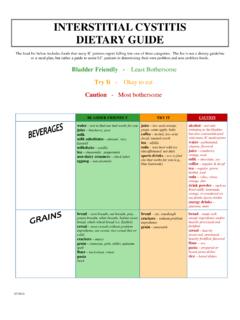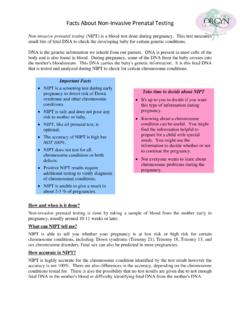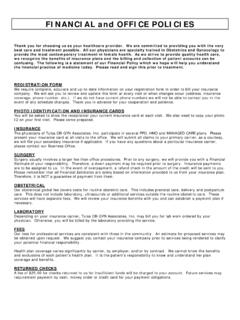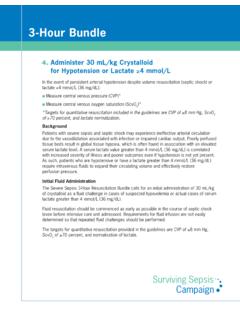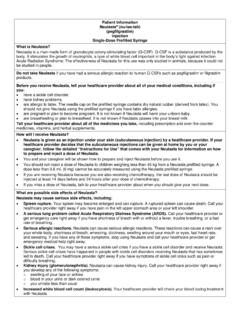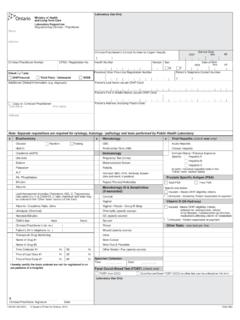Transcription of URODYNAMICS PATIENT INSTRUCTIONS
1 URODYNAMICS PATIENT INSTRUCTIONS PATIENT NAME:_____ APPOINTMENT:_____ ARRIVAL TIME:_____ DATE TIME 15 minutes before appt. You have been scheduled for a URODYNAMICS study. This test is to help your doctor determine how your bladder and pelvic muscles may be working inappropriately. *If you take Enablex, Detrol, Ditropan, Sanctura, Vesicare, Oxytrol or their generic equivalent stop taking 2 3 days before URODYNAMICS study, or call the office if you have questions or are unsure of medication. Directions for the day of the procedure: Empty your bowels before coming to the office use one Fleets enema the morning of your test Bring your completed questionnaire and bladder diary Unless otherwise directed by your doctor.
2 You should take your normally scheduled medications* Bring an extra pair of socks Do NOT wear lotion on your legs Empty your bladder 1 hours prior to your appointment time o then begin drinking water frequently until your appointment you should arrive in the office with a comfortably FULL bladder o you may eat before your appointment The procedure will begin with you undressing from the waist down. We will review the bladder diary and questionnaires with you and then you will empty your bladder on a special chair. A small catheter is inserted into your bladder; and another catheter will be inserted into the rectum.
3 Two patches (like EKG electrodes) will be placed next to your rectum. We will attach all of the catheters and electrodes to a small computer and start filling your bladder with sterile water. You will be asked about the sensations you are having while your bladder is filling. There are no right or wrong answers to these sensations. Do NOT be afraid to leak urine we want to determine which specific muscles are not working by causing you to leak during this test. We will explain everything to you as it happens. The only discomfort you may have will be a stinging sensation when the catheter is inserted in the bladder.
4 This sensation will disappear after a few minutes. The series of tests typically takes about one hour. You will be able to resume all previous activities, including driving, upon completion of the URODYNAMICS studies. If you have any questions, please call the office 918 747 9641. If you need to reschedule your appointment, please call at least 24 hours before your appointment. URODYNAMICS DIAGNOSTIC PROCEDURE WHAT IS URODYNAMICS ? URODYNAMICS refers to a series of diagnostic tests that evaluate the function of your bladder and urethra. These tests may be recommended if you have urinary incontinence (leakage of urine), recurrent bladder infections, a slow/weak urinary stream, incomplete bladder emptying, or frequent urination.
5 URODYNAMICS testing provides valuable information to aid in the accurate diagnosis of your urinary problems. HOW TO PREPARE FOR URODYNAMICS Prior to your appointment you will be asked to complete a bladder diary and questionnaire. Please bring these with you to the appointment. Unless otherwise directed by your doctor, you should take your normally scheduled medications. You may eat and drink prior to the study. *If you take Enablex, Detrol, Ditropan, Sanctura, Vesicare, Oxytrol or their generic equivalent stop taking 2 3 days before URODYNAMICS study, or call the office if you have questions or are unsure of medication.
6 The series of tests typically takes about one hour. You will be able to resume all previous activities, including driving, upon completion of the URODYNAMICS studies. Your physician will decide which of the following procedures are appropriate for you. UROFLOWMETRY This study measures your urinary flow rate. You should come to the test feeling as though you need to urinate. Try not to empty your bladder one hour before your test is scheduled. You will be asked to urinate into a special commode that allows a computer to measure your urine flow rate and voided volume. EMG This study measures how well you can control your sphincter (outlet) muscles and helps determine if they are working in coordination with your bladder.
7 Sticky patches (electrodes) will be placed near the rectum to record sphincter muscle activity. CYSTOMETROGRAM This study measures your bladder capacity, evaluates how your bladder holds urine, and determines how well you can control your bladder muscle. One very small catheter will be placed in your bladder, and another will be placed in your rectum. These catheters will measure both the pressure inside your bladder, and the pressure your body exerts on your bladder. You will be asked to report the sensations you feel as your bladder is filled (such as when you first feel the need to urinate and when that feeling intensifies).
8 You will be asked to cough or bear down during the test to check for leakage of urine. Do NOT be afraid to leak urine we want to determine which specific pelvic muscles are not working by causing you to leak during the test. At the end of the study, you will be asked to urinate again. PRESSURE FLOW STUDY This study measures how well the bladder muscles, the sphincter, and the urethra work together. This test may be done sitting or standing. Your bladder will be filled until you feel that your bladder is completely full. You will then be asked to urinate. The computer will measure the strength of your bladder muscles and sphincter, as well as the urinary flow rate and voided volume.
9 URETHRAL PRESSURE PROFILE The Urodynamic catheter is placed in the urethra and it will calculate the urethral closure pressure and the bladder pressure simultaneously. this result will be documented by the computer and provide additional information for your diagnosis. TREATMENT OPTIONS BIOFEEDBACK & PELVIC FLOOR THERAPY This non surgical form of therapy is used to retrain the pelvic floor and/or bladder muscles. Typically, pelvic floor therapy consists of weekly sessions for six weeks. The first session will last about one hour, but the remaining sessions will be shorter. Using biofeedback and electrical stimulation techniques, a therapist will evaluate your muscle strength and instruct you on how to properly isolate and exercise these pelvic floor muscles.
10 A computer can be used to guide you and monitor your progress. You will be educated in these techniques so that you can continue the exercises at home. MEDICATION Some prescription medication options may be available. Your doctor will discuss the results of your testing and if there are any prescription options right for you. SURGERY Your doctor will discuss any surgical options that are appropriate for you, based on your study results. Tulsa OB-GYN Associates, Inc. Physician: _____ Name:_____ Age:_____ Date of Birth:___/___/___ Height:_____ Weight:_____ Age of Menopause:_____ # of Pregnancies:_____ # Vaginal Births:_____ # C-Sections:_____ Do you smoke?
